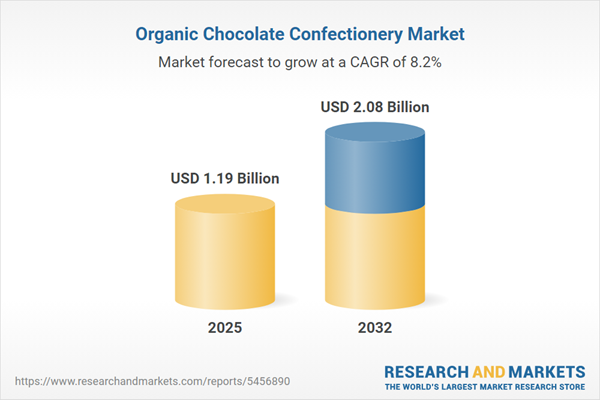Speak directly to the analyst to clarify any post sales queries you may have.
The organic chocolate confectionery market is rapidly evolving as senior executives face increasing pressure to address sustainability, regulatory demands, and product innovation. An emphasis on responsible sourcing, supply chain transparency, and adaptable business models is reshaping strategic priorities for industry leaders navigating this dynamic sector.
Market Snapshot: Organic Chocolate Confectionery
Strong demand is propelling the organic chocolate confectionery market, with stakeholders seeking premium, responsibly sourced products and higher operational standards. As organizations across the value chain adjust procurement practices, transparent sourcing and documentation are emerging as critical drivers for compliance and differentiation. Heightened focus on supply risk and supplier relationships, alongside competitive global dynamics, is influencing strategies related to market entry and alliances. Senior leaders are working to optimize performance advantages through adaptability and informed decision-making in this complex landscape.
Scope & Segmentation: Key Segments in Organic Chocolate Confectionery
- Product Types: Variants include dark chocolate in various cocoa concentrations, milk chocolate with lower sugar content, and select white chocolate options, allowing enterprises to address B2B needs and nutritional aims.
- Flavor Profiles: Available options incorporate fruit-infused (such as berry or orange), spiced (including chili or cinnamon), and nut-based flavors like almond or hazelnut to expand product diversity and brand distinction.
- Packaging Formats: Choices span resealable bags, multi-bar packs, premium gift boxes, and standard packets, increasingly featuring recyclable or biodegradable solutions to meet environmental and procurement standards.
- Distribution Channels: Channels cover supermarkets, specialty stores, drugstores, hypermarkets, convenience stores, and e-commerce, enabling broad B2B reach and rapid adaptation to market trends.
- Geographic Coverage: Major regions encompass North America, Latin America, Europe, Middle East & Africa, and Asia-Pacific, each requiring specific market entry and product customization strategies aligned with local regulations and consumer behavior.
- Notable Industry Participants: Key companies include PASCHA CHOCOLATE CO, Theo Chocolate, Inc., Rococo Chocolates London Limited, Pana Chocolate Pty Ltd., Original Beans, DOISY and DAM, Green & Black's, Lake Champlain Chocolates, Love Cocoa, and Daylesford Organic Limited, focusing on innovation, strategic alliances, and vertical integration to maintain competitive positioning.
Key Takeaways for Senior Decision-Makers
- Transparent supplier and ingredient sourcing practices are reinforcing trust and enhancing brand credibility throughout procurement ecosystems.
- Sustainability initiatives within core operations support continuity while enabling proactive responses to evolving sector obligations.
- Adopting eco-friendly packaging strengthens B2B engagement, supports compliance, and reflects sensitivity to environmental concerns.
- Leveraging small-batch production models increases flexibility, allowing tailored offerings for specific regional and niche market preferences.
- Deployment of clean-label ingredients and adaptation to local tastes improve process integration and regional market alignment.
- Comprehensive risk management across logistics, procurement, and compliance frameworks underpins organizational stability, particularly during global supply chain disruptions.
Tariff Impact: Navigating Regulatory Change
Shifts in US tariff regulations have driven organizations in the organic chocolate confectionery market to reevaluate procurement and sourcing policies. Strengthening collaboration with suppliers and advancing inventory strategies are helping maintain supply continuity and reduce financial risks as regulatory parameters evolve. This environment requires adaptive partnership models and robust risk assessment for ongoing resilience.
Methodology & Data Sources
Insights in this report are grounded in interviews with senior executives, validated by international trade data, and supported through comprehensive analysis of official industry reports. This mixed-method approach yields actionable, accurate perspectives for strategic decision-making.
Why This Report Matters
- Offers tailored guidance for senior leaders to enhance innovation, resource planning, and strategy formulation within the organic chocolate confectionery sector.
- Delivers region-focused intelligence, simplifying market entry and expansion while accounting for diverse regulatory environments.
- Integrates insights on supply chain, regulatory, and consumer trends, informing investment and procurement choices across the business.
Conclusion
Ongoing progress in the organic chocolate confectionery market depends on adapting to sustainable practices, leveraging technological advances, and anticipating market needs. This report equips decision-makers with the understanding required to strengthen organizational competitiveness and handle sector challenges confidently.
Additional Product Information:
- Purchase of this report includes 1 year online access with quarterly updates.
- This report can be updated on request. Please contact our Customer Experience team using the Ask a Question widget on our website.
Table of Contents
3. Executive Summary
4. Market Overview
7. Cumulative Impact of Artificial Intelligence 2025
Companies Mentioned
The companies profiled in this Organic Chocolate Confectionery market report include:- PASCHA CHOCOLATE CO
- Theo Chocolate, Inc.
- Rococo Chocolates London Limited
- Pana Chocolate Pty Ltd.
- Original Beans
- DOISY AND DAM
- Green & Black's
- Lake Champlain Chocolates
- Love Cocoa
- Daylesford Organic Limited
Table Information
| Report Attribute | Details |
|---|---|
| No. of Pages | 196 |
| Published | October 2025 |
| Forecast Period | 2025 - 2032 |
| Estimated Market Value ( USD | $ 1.19 Billion |
| Forecasted Market Value ( USD | $ 2.08 Billion |
| Compound Annual Growth Rate | 8.1% |
| Regions Covered | Global |
| No. of Companies Mentioned | 11 |









